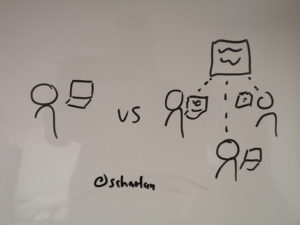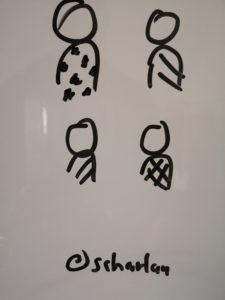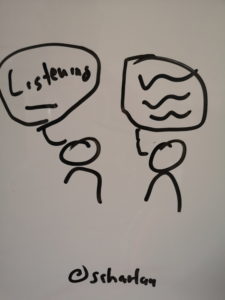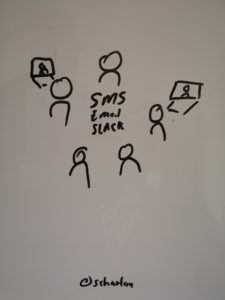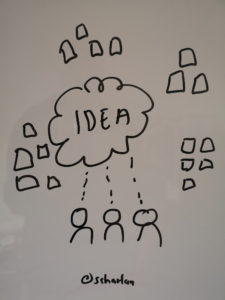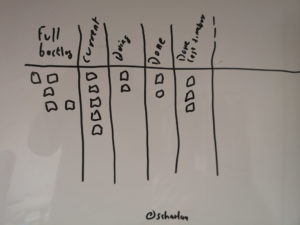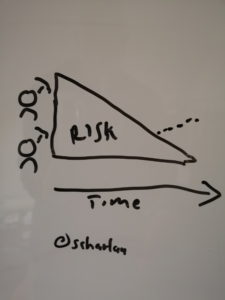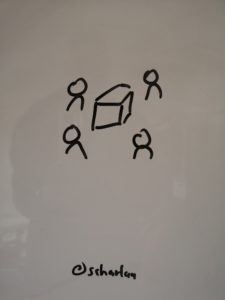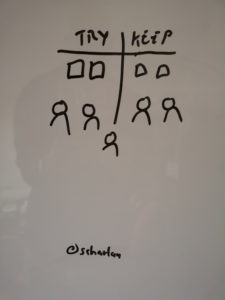Team collaboration requires a place where people can work together to see the work needing to be done, and to share ideas, as well as track progress. What follows are suggestions of how you can do this work together, along with links to resources to help you.
1. Why bother to collaborate?
Maybe you’ve been told you have to do this work as a team. Maybe that’s just the nature of the work you do. Whatever the case, there is much to think about when you start a collaboration.
You can do more with a team, than you can do on your own.
You will learn from your team members, and they will learn from you too.
There is more to gain from the collaboration experience, than the ‘thing’ you’re doing together.
Employers like to know you have experience, and you also have more to learn.
Know why you want to participate, and what your goal is in the collaboration.
You might want to consider the opportunities it might provide.
https://www.weforum.org/agenda/2020/01/reskilling-revolution-jobs-future-skills/
2. Who’s on the team?
You can join any team if it’s a small collaboration. For more important ones, you should consider who you work with if you want to make the most of the experience.
The key things Google found were that successful teams rely upon trust. You build this by listening to each other, building empathy for each other, and asking questions to show you were listening to your team member. https://www.inc.com/justin-bariso/google-spent-years-studying-successful-teams-heres-thing-that-mattered-most.html
It takes a variety of roles for collaboration to work, and you should also be aware of your preferences for the types of team work that exist too.
Diversity trumps homogeneity, so create a diverse team.
Stay focused on the goals you want from the experience when working with friends.
Belbin roles – who does what in the team
https://www.belbin.com/resources/session-ideas-handouts/
Basadur profile – do you prefer to generate ideas, develop them, optimise them, or get them done?
https://media1-production.mightynetworks.com/asset/2451528/en-us_profile_booklet.pdf
3. How do we work together?
A team works best when it has a shared vision of where it wants to go, and how it will get there. Before you can do that, you need to agree on how the team works together. You need to trust your team members to do the right thing, and to create guidance for everyone on what the ‘right thing’ might be.
Use a work agreement such as this template I use with students.
Do something social together to build trust and empathy. You can use So Cards https://www.socards.org work well for connecting people, or just share a meal or coffee together.
Coordinate across time zones https://www.timeanddate.com/worldclock/meeting.html
Give everyone access to all of the tools you’re using.
Ensure that everyone has the same, or similar tools, and that they work smoothly together.
Work with partners on all tasks to spread knowledge within the team, and rotate the partners to keep spreading knowledge.
Ensure that everyone has a voice and talks on the team, so that their perspectives and insights aid the team too.
4. How do we talk to each other?
On the one hand, the team needs to be able to talk to each other knowing that they can do so safely, and that their voice will be heard. On the other hand, if the team sees that someone is in difficulty, then they need to feel that they can discuss this in a supportive manner. In between these two positions, are many others.
Crucial conversation exercise
dialogue for teamwork and exercises
When you notice dissonance in the team, then slow down and find out how these different perspectives can help the team.
Build mutual purpose between team members so that you have a win/win situation.
5. How do we stay in touch?
The team members need to be able to communicate with each other to achieve their goals. They need to do this for regular meetings, and updates. They also need a channel that enables urgent communication between members when something needs immediate attention.
Use whatever most people are already familiar with, and find comfortable to use. You might need two different methods depending upon your circumstances.
Set up calendar entries for meetings (send invites even) so that the dates are known in advance.
Use google translate as required if team members are more comfortable in different languages. Use this in meetings as required.
For written communication you might create a WhatsApp, or Messenger group, but could also be a team on Microsoft Teams, or Slack. The goal is to have something simple to use which everyone will see on a regular basis, for those times when an urgent decision needs to be made. Create one channel per topic so that conversations are easier to follow.
For regular team meetings, if you can’t meet in person, then you can use Microsoft Teams, Skype, Zoom, or other similar tool and set up a regular series of meetings depending upon the frequency required as daily, weekly, fortnightly, etc.
6. How do we know how much there is to do?
Estimation is often wrong unless it is something we have done before. It might also be pointless, if the overall work is small. It might be better to list and then priortise the items, and then start the work instead of working them all out in detail.
Visualise the work you think that you need to do. Use Trello https://trello.com or Jira https://www.atlassian.com/software/jira to create task boards to detail the work to be done. Start by just listing the tasks, or pieces of work that need to be done.
You could also use a Miro whiteboard https://miro.com to dump ideas out using virtual sticky notes. This would let you put ideas into groups, and other organise them to better understand what needs doing.
Slice items down to ‘about a day’s worth of work’ so that it is easier to envision how much work is required.
If you’re timeboxing the work in chunks, then ensure that no item is bigger than a timebox.
7. How do we decide what order to do the work?
We work better when we work together, and that means deciding where to start.
During planning you should prioritise the work to be done. This should be done across the whole of the project or product so that you have a rough idea of which items are done earlier, and which ones done later.
Use Trello https://trello.com or Jira https://www.atlassian.com/software/jira to take your list of tasks and break these down into categories. For the simplest task board you can start with columns labelled ‘Backlog’ (to hold all of the tasks you will need to do), ‘Current’ (for those tasks you are doing in this round of work), ‘Doing’ (for those tasks being worked on at the moment), and ‘Done’ (for completed tasks). If you want to create a progress chart, then at the end of each round of work, rename ‘Done’ to ‘Done <end date of round>’ and create a new ‘Done’. Then you will be able to see how many tasks were finished each round. Prioritise tasks when they make it to the ‘current’ column.
You can also use Miro whiteboards https://miro.com. Miro offers a range of templates to use for various types of work. You could create your own task board using virtual sticky notes, and use this for other team discussions and design decisions too. You can also use a Google jamboard too, although this has the least amount of functionality, but does let anyone edit the board. For Miro you need to invite team members to share your board.
Prioritise the work so that you eliminate risks first.
Organise the work into workable chunks so that at the end of a timebox you have something workable. If this is a report, then a poor first draft, a better draft after that, etc. If this is software, then a skeleton feature should be done first, then add more functionality with each successive slice.
8. How do we remove risk from our work?
Suprises happen in all work. The goal is to have them happen sooner rather than later.
You should identify the riskiest parts of the work and do those as early as possible. Then remove the next riskiest part and so one. Sometimes you can do this through mitigation, or avoidance, but not always. This is why you do them early and remove them so that you know they are resolved and don’t hold you up later in your work. The goal is to remove the likelyhood of surprises, which slow down, or endanger the work you’re doing. If surprises, happen, then it is better to have them appear as soon as possible in the work, so that the team vision is still possible.
Use the other practices mentioned here so that you improve the shared understanding within the team, and ensure the combined work is stored on more than one person’s device, or in the cloud.
Turn all team members into generalists, so that you have no experts. This removes any failure for the team due to one person being suddenly unavailable.
Do everything in pairs, or as a mob, so that you continually spread knowledge within the team.
Identify all of your risks and assumptions, and then rate them by likelihood of happening, and impact on your work if they do happen. Now determine how you can validate your assumptions, and remove the risk for each of them. Then start to do the work to remove the risk starting with the riskiest items first so that you no longer have to worry about this. By doing this you make success more likely.
A key risk is producing the ‘output’. That might be the report, the poster, or deploy the software for others to use and see. You should always start with determining how you will do this, and to start ’test’ versions as soon as possible to avoid any surprises at the end.
Keep integrating the work of everyone regularly from the start of your work, to avoid any surprises later.
9. How do we pull the work together?
Any team where one person is late, or the work is to the wrong standard (plagiarised), or where the team works in big slices makes integration hard. The team works best when people are present to do the work, communicate regularly, and do the work (integrate their work) in small slices.
The results of your collaboration need to be combined with the contributions from everyone. There are a number of ways to do this, and different aspects that you need to consider.
First, you need to be able to show your work to your team members. At the very least you should be able to share your screen so that others can see your work. This way you can pair and mob on the work with a ‘driver’ sharing their screen, and a ’navigator’ telling the driver what to type, with others (the mob) offering up ideas to the navigator. When you rotate roles, then the file is sent to everyone and the work continues. At any one point, however, only one person has the ‘current’ version.
Second, you should be able to work together on the same document at the same time. For this you can use any number of online options from MS Office 365, Google Docs, Miro, etc. Working in the cloud safeguards your work against loss of any one persons device too. With this option you can all work simultaneously on the same document, and consistently revise each others work. You could also use the same pairing and mobbing approach mentioned above without having to send the file from person to person.
Third, use a version control system such as GitHub https://github.com or BitBucket https://bitbucket.org/product/ to keep different versions of your work. While mostly used for software development, these can be used to store other documents too. One person creates a repository, and then shares the repository with other collaborators. A website can also be hosted this way too using ‘GitHub Pages’.
GitHub has free programmes for students and academic institutions https://education.github.com, which mean staff can sign up and manage classroom repositories easily using GitHub Classroom https://classroom.github.com. This provides a ‘Pro’ account, so you can also have private repositories and use other tools as well.
Fourth, consider how you put together the final version of your work. If that means putting everything into one document, and proofreading, and formatting, then plan for the time this takes to do. It always takes more time than you think it will. That means you need to start as soon as possible, even if that only means creating a table of contents and clarifying how you’ll fill this in later.
If this is a software application collaboration, then that means putting your software onto Heroku https://www.heroku.com, AWS https://aws.amazon.com, Google Cloud https://cloud.google.com, or wherever, and also uploading any data for the databases. Start to deploy as soon as you have a ’slice’ of everything for one feature such as database, server, front end.
10. How do we review what we did?
The team is always learning during their collaboration. At the end of each timebox take the time to review how you did the work so that you can improve its processes. Each of these is a format for a team discussion on how they might improve the way they work. Some ideas will work, others will be found to not work. That is ok. This is a learning process, which needs to be followed in order to improve how the team works.
Pause to review your work regularly, so that you can improve how you work. Common questions to ask are ‘what could we try in the next round’, or ‘what should we definitely keep doing’? Other options are the ‘starfish’ categories of ‘keep, stop, start, do more of, do less of’ to explore how you might improve on the next round.
Use https://funretro.io/ to review your work regularly, such at the end of a timebox. Create columns on the topics and then ask team members to quietly add them at the start of a session. Then vote on them, and then discuss them to find how you might improve your next round of work.
Conclusion
Start from where you are and implement ideas that look like they might work for you. If you’ve already started your collaboration, then introduce the most obvious suggestions first, and some of the other ones, that might mean changes later. If you’re just starting out, then use this as a checklist, and follow the other guides too for ‘team participants‘ and for ‘team organisers‘.

